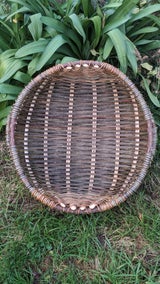SOLD - Special Selection 22" Welsh Cyntell - Rose Wood Hoop and Ribs
Beautiful split rib Cyntell basket woven from Pembrokeshire Willow but with a stunningly textural rosewood frame and ribs - unique! These baskets are wonderful as log baskets or storage baskets - even for laundry for a large family!
This one is particularly large so bear in mind that it would be heavy if filled with laundry or logs - but it does look beautiful in situ.
This is woven from my own Norbury, Packing Twine and Polish Blue willow, the band of Old French willow highlights the lovely curve.
Gwyntell
From the University of Wales Dictionary:
gwyntell (or gwintell, wintell): Basged gron heb ddolen iddi wedi ei phlethu o wiail cyll neu helyg at ddal tatws, tywyrch, dillad, &c [round basket of woven hazel withies or osiers, without a handle, used to hold potatoes, turfs, clothes, &c.] The word may also refer to the method of construction - plethwaith, rhwylliaith [plaited work, lattice work - compare a similar use of the word wicker in English]
The Cyntell is the traditional Welsh framed farm basket which was used for many agricultural purposes. It was mainly found in West Wales where it was woven from materials found in hedgerows around the farm.
The baskets range between 12 and 22 inches in diameter and were originally designed to fit into each other for storage when the baskets were not being used. The size of the basket is determined by the diameter of the hoop.
The hoop for the Cyntell is made from very stout hazel or willow (or even sometimes dog rose) which is harvested in the winter months and wrapped round a circular forma – originally this could have been an old cartwheel or barrel - made from MDF or an old bicycle wheel. This is left to dry naturally for up to a year. Once the hoop has dried it is joined by cutting two sloping cuts called slypes that fit snugly together and then wood glue is used to ensure a really strong frame.
The Cyntell basket has 8 thick ribs which are made by splitting very stout willow or hazel in half using a knife. The ribs are then shaped by shaving the sharp edges off to form an oval which will not skin the weaving willow as it passes over the ribs. The ideal shape is an almond ‘eye’ shape with no sharp edges. It takes a lot of practice to achieve this! The first 4 ribs of the basket are then also dried on formas which have been passed down through the generations and which have a specific curved angle to make the bottom of the basket sit flat on the floor or surface.






